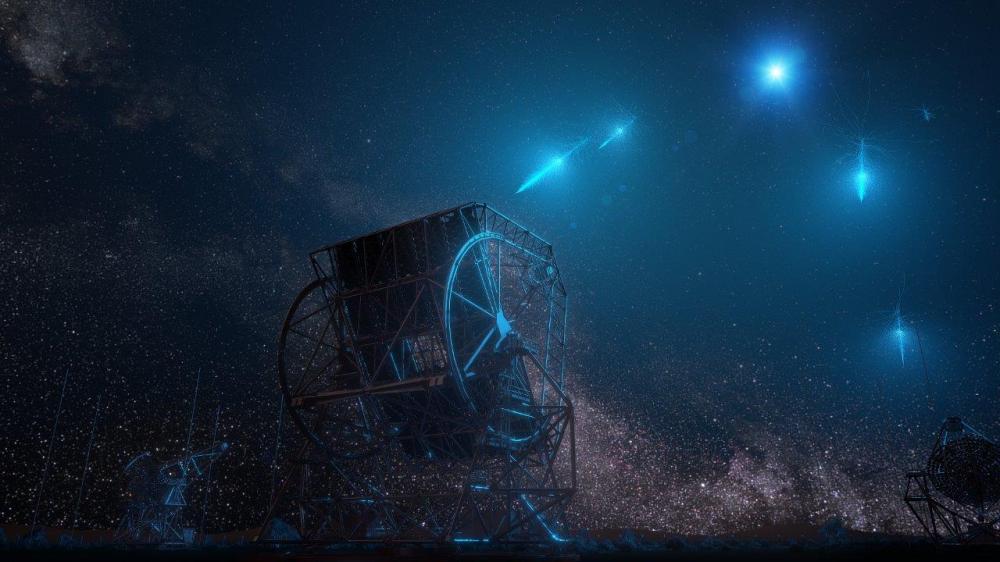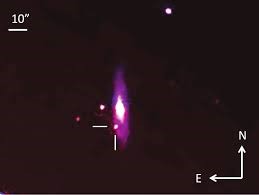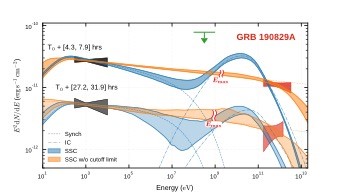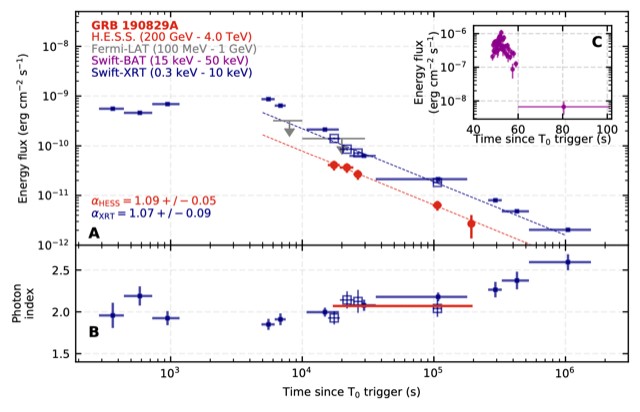
Illustration of the H.E.S.S. telescopes detecting the particle sprays resulting from the interaction of high energy photons in the atmosphere. DESY - Science Communication Lab
On August 29, 2019, scientists from the H.E.S.S. collaboration record one of the brightest cosmic explosions ever observed in the universe. This gamma-ray burst emitted the most energetic photons ever detected in this type of event. The analysis of the data collected calls into question the origin of the rays produced during the explosion. These results has been published by the international team, including researchers from CEA and CNRS, in the journal Science on June 4, 2021.
H.E.S.S. (High Energy Stereoscopic System), located in Namibia, is a system of five Cherenkov imaging atmospheric telescopes that has been studying cosmic rays since 2003. In 2016, the cameras of the first four telescopes were completely refurbished using state-of-the-art electronics and in particular the NECTAr readout chip designed by a DEDIP/Irfu laboratory.
"Gamma-ray bursts are bright flashes of X-rays and gamma rays observed in the sky, emitted by distant extragalactic sources," explains Edna Ruiz Velasco of the MPIK in Heidelberg, Germany, one of the corresponding authors of the paper. "These are the most violent explosions in the Universe and those that last longer than a few seconds are likely associated with the collapse of a massive star into a black hole."
Surge emissions are divided into two distinct phases:

Image by the GTC optical telescope of the
GRB190829A and its host galaxy J025810.28- 085719.2. Credit Hu, et al. (2021).
The exceptional observation of the closest gamma-ray burst ever recorded
The GRB19829A burst was detected by the Fermi and Swift space observatories on August 29, 2019. The burst itself is not exceptionally bright. However, it was located in a relatively close galaxy: its redshift was measured by the GTC optical telescope at z= 0.0785 (still corresponding to ~1.1 billion light-years). The detection of a gamma-ray burst so close is an exceptional and rare event. For comparison, typical bursts are located at about 20 billion light-years.
The team captured the afterglow of the explosion as soon as it became visible to the H.E.S.S. telescopes. "The signal was strong enough to be detected immediately! This allowed us to quickly inform the world community", notes Fabian Schüssler from CEA-Irfu who coordinates the team in charge of the analysis of this gamma-ray burst.
Observations of GRB190829A with H.E.S.S.
H.E.S.S. observed the GRB190829A outburst the night after the detection by the space instruments and immediately detected a very high energy gamma-ray signal.
Under the direction of Irfu researchers, observations continued for several days and analyses revealed that the signal was visible for three consecutive days with statistical significance of 21.7 σ, 5.5 σ and 2.4 σ. The data obtained by H.E.S.S. thus cover the period from 4 hours to 56 hours after the detection of the burst. A record! Another record is set by the energy of the gamma rays: up to 3.3 TeV! Never seen from a gamma-ray burst. These observations have thus firmly established the presence of very high energy gamma rays in the afterglow of gamma-ray bursts.
But like all scientific discoveries, they have also opened new questions: How are these photons of such high energy created? The theoretical models most used until now do not manage to reproduce the observations and must be modified...
An observation that challenges the theory of gamma-ray bursts in the Universe
The analysis of the GRB190829A observations with H.E.S.S. established four main outstanding results:


Promising prospects
"H.E.S.S. was able to follow the afterglow for up to three days after the initial explosion" explains Fabian Schüssler. The result was surprising: the observations revealed curious similarities between the X-ray and very high energy gamma-ray emissions of the afterglow. Contrary to established theories that assume that the two components of the emission must be produced by separate mechanisms, the observations of the GRB 190829A afterglow show that the X-rays and gamma rays decayed in a synchronized manner. Moreover, the gamma-ray energy spectrum clearly corresponds to an extrapolation of the X-ray spectrum. These results indicate that the X-rays and very high energy gamma rays in this afterglow were produced by the same mechanism and at the same time.
"The significance of this possibility underscores the need for further studies of the afterglow emission of very high-energy gamma-ray bursts," notes Mathieu de Naurois, deputy director of the H.E.S.S. Observatory and researcher at LLR, France.
GRB 190829A is only the fourth gamma-ray burst detected from the ground. However, the previously detected explosions occurred much farther out in the Cosmos and their afterglow could only be observed for a few hours each and not at energies above 1 tera-electronvolt.
The prospects for detecting gamma-ray bursts with next-generation instruments look promising: scientists expect that regular detections in the very high-energy band will become common with improved instruments, which will help to fully understand these gargantuan cosmic explosions.
Reference:
Revealing x-ray and gamma ray temporal and spectral similarities in the GRB 190829A afterglow; H.E.S.S. collaboration; Science, 2021; DOI: 10.1126/science.abe8560
